735. Magpie Shrike (Formerly known as Long-tailed Shrike) Urolestes melanoleucus (Afrikaanse Langstertlaksman)
Order: Passeriformes. Family: Laniidae
Description
45 cm. A distinctive, long-tailed, pied bird. Black and white plumage and a striking, long, graduated tail.
Sexes similar. Female has creamy white flanks, that are lacking on the male.
Juveniles have a shorter tail and dark brown plumage. Immature is bronze-brown with a grey rump.
Distribution
It has three separate populations - one in Kenya and Tanzania, another in Malawi and northern Mozambique and the largest one from Angola and Zambia to southern Africa. Here it locally common in Zimbabwe, Botswana, north-eastern Namibia, Limpopo Province, Gauteng and North-West Province.
Habitat
It favours open savanna woodland with short grass clumps and bare ground, also occurring in broad-leaved woodland and disturbed areas with Acacia tree stands, such as in suburban gardens and town parks.
Diet
It mainly eats insects (also small reptiles, mice and fruit), using a variety of foraging techniques. It often perches in a prominent position, searching for a food item. Once it spots something it dives to the ground and catches it. It also gleans prey from leaves and branches, and sometimes searches for them at ground level.
Breeding
Monogamous. A facultative cooperative breeder, meaning that the breeding pair or assisted by 1-3 helpers who are usually juveniles from the previous brood. Nest construction is handled by both sexes - group members have never been observed assisting them. It basically consists of an untidy cup made of twigs, grass stems and roots, typically placed in the upper branches of an Acacia tree. Egg-laying season peaks from October-January. It lays 2-6 yellowish eggs, which are incubated solely by the female for about 16 days, the male and group members providing her with food. The chicks are cared for both parents and group members, leaving the nest after about 15-19 days. As it usually lays two clutches per breeding season the fledglings help to rear the next brood.
Call
The call is a clear fluid theeu-teewoo and several birds may call at the same time. Often the males and females will call in duet, each contributing a part of the call. Listen to Bird Call.
Status
Common resident, sedentary but moves locally in response to drought and fires. Usually in groups of 3-12 birds.
Africa Wild Bird Book
- Flutterby
- Posts: 44029
- Joined: Sat May 19, 2012 12:28 pm
- Country: South Africa
- Location: Gauteng, South Africa
- Contact:
Magpie Shrike Photos
735. Magpie Shrike Urolestes melanoleucus
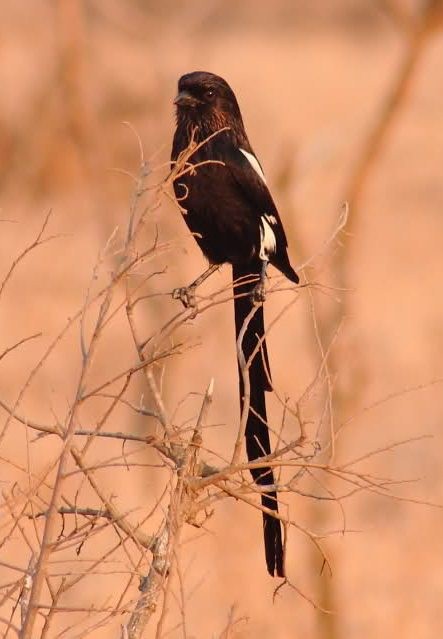
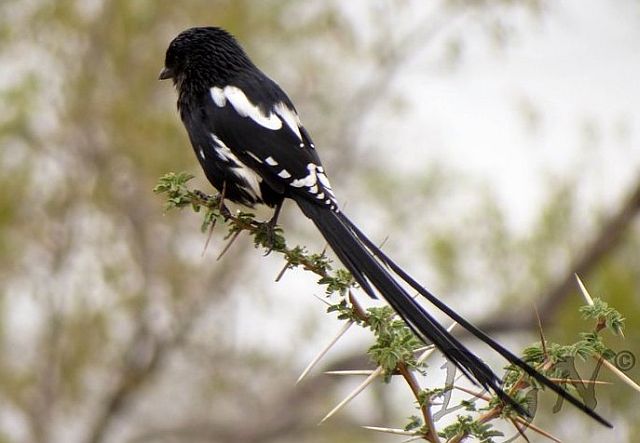 © JustN@ture
© JustN@ture
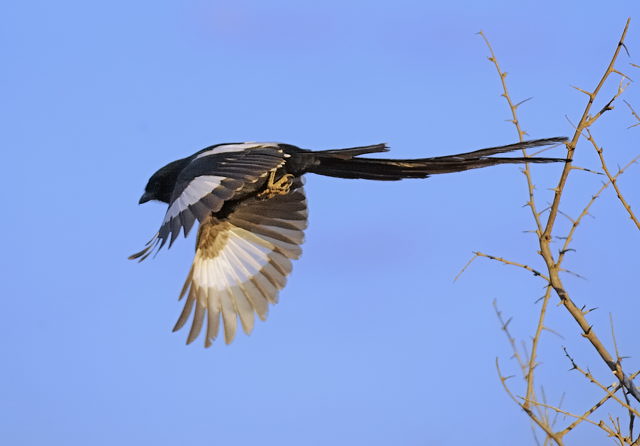 © Dewi
© Dewi
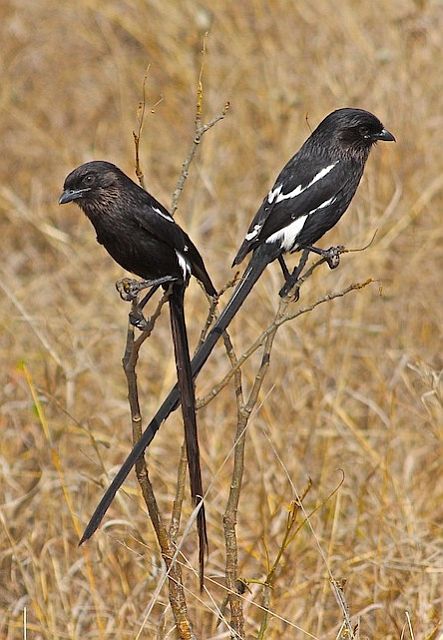 © ExFmem
© ExFmem
 © ExFmem
© ExFmem
Links:
Species text Sabap1
Sabap2

 © JustN@ture
© JustN@ture © Dewi
© Dewi © ExFmem
© ExFmem © ExFmem
© ExFmemLinks:
Species text Sabap1
Sabap2
Southern White-crowned Shrike
756. Southern White-crowned Shrike (Formerly known as White-crowned Shrike) Eurocephalus anguitimens (Kremetartlaksman)
Order: Passeriformes. Family: Laniidae
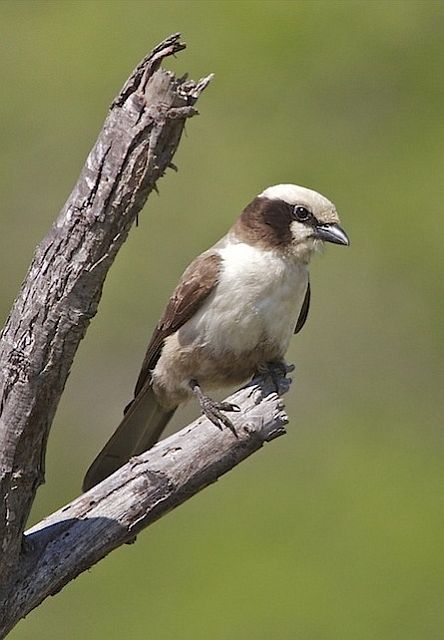 © ExFmem
© ExFmem
Description
Large (24 cm) stocky white and brown shrike with white crown and forehead contrasting the dark brown side of the head, wings and tail. The throat and breast are also white, while the belly and flanks are washed with buff.
Adult: Head, forehead, crown, nape white. Face-mask formed by dark line from bill below the eye to large dark brown patches on ear-coverts and sides of neck. Back ashbrown, darker on lower back and rump. Wings and tail dark brown. Underparts chin, throat and breast white, changing to ashbrown on belly and flanks, underwing and undertail coverts pale brown. Bill black, legs dark brown, eyes dark brown. Sexes alike.
Juvenile: Head and back pale ashbrown, nape cream like underparts, brownish black face-mask much reduced, lacks dark ear-coverts, bill pale yellowish.
Distribution
Near-endemic to southern Africa, occurring from the North West and Limpopo Provinces to south-Eastern Mozambique, Zimbabwe, Botswana and northern Namibia (North, central and south-eastern Namibia. Found in Etosha National Park, Erongo Mountains, Epupa Falls, Rundu and the Caprivi Strip), extending marginally into southern Angola.
Habitat
It generally favours savanna woodland with sparse ground cover, as well as deciduous and riverine woodland.
Diet
It mainly eats insects (caterpillars, beetles, ants, wasps and millipedes), often perching in a prominent position, searching for a food item. Once it spots something it dives to the ground and catches it. It also hunts at ground level and often joins mixed-species flocks.
Breeding
Monogamous. A facultative cooperative breeder, meaning that the alpha female and male or assisted by about 1-4 helpers. The breeding pair as well as group members construct the nest, which is a neat cup built of fine, shredded grass reinforced with spider web. It is typically placed in the horizontal fork of a branch. Egg-laying season peaks from October-November. It lays 2-5 eggs, which in one observation where incubated mainly by the alpha female for about 20 days. The chicks are cared for by both group members and the breeding pair, leaving the nest after about 19-20 days.
Call
Utters a shrill nasal kwee-kwee-kwee. Listen to Bird Call.
Status
Common, near-endemic resident, sedentary with some nomadic movements recorded. In pairs or small groups of 4-8 birds.
Order: Passeriformes. Family: Laniidae
 © ExFmem
© ExFmemDescription
Large (24 cm) stocky white and brown shrike with white crown and forehead contrasting the dark brown side of the head, wings and tail. The throat and breast are also white, while the belly and flanks are washed with buff.
Adult: Head, forehead, crown, nape white. Face-mask formed by dark line from bill below the eye to large dark brown patches on ear-coverts and sides of neck. Back ashbrown, darker on lower back and rump. Wings and tail dark brown. Underparts chin, throat and breast white, changing to ashbrown on belly and flanks, underwing and undertail coverts pale brown. Bill black, legs dark brown, eyes dark brown. Sexes alike.
Juvenile: Head and back pale ashbrown, nape cream like underparts, brownish black face-mask much reduced, lacks dark ear-coverts, bill pale yellowish.
Distribution
Near-endemic to southern Africa, occurring from the North West and Limpopo Provinces to south-Eastern Mozambique, Zimbabwe, Botswana and northern Namibia (North, central and south-eastern Namibia. Found in Etosha National Park, Erongo Mountains, Epupa Falls, Rundu and the Caprivi Strip), extending marginally into southern Angola.
Habitat
It generally favours savanna woodland with sparse ground cover, as well as deciduous and riverine woodland.
Diet
It mainly eats insects (caterpillars, beetles, ants, wasps and millipedes), often perching in a prominent position, searching for a food item. Once it spots something it dives to the ground and catches it. It also hunts at ground level and often joins mixed-species flocks.
Breeding
Monogamous. A facultative cooperative breeder, meaning that the alpha female and male or assisted by about 1-4 helpers. The breeding pair as well as group members construct the nest, which is a neat cup built of fine, shredded grass reinforced with spider web. It is typically placed in the horizontal fork of a branch. Egg-laying season peaks from October-November. It lays 2-5 eggs, which in one observation where incubated mainly by the alpha female for about 20 days. The chicks are cared for by both group members and the breeding pair, leaving the nest after about 19-20 days.
Call
Utters a shrill nasal kwee-kwee-kwee. Listen to Bird Call.
Status
Common, near-endemic resident, sedentary with some nomadic movements recorded. In pairs or small groups of 4-8 birds.
Southern White-crowned Shrike Photos
756. Southern White-crowned Shrike Eurocephalus anguitimens (Kremetartlaksman)
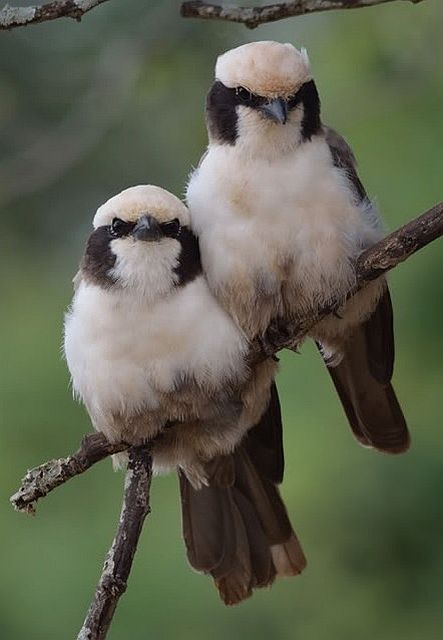 © BluTuna
© BluTuna
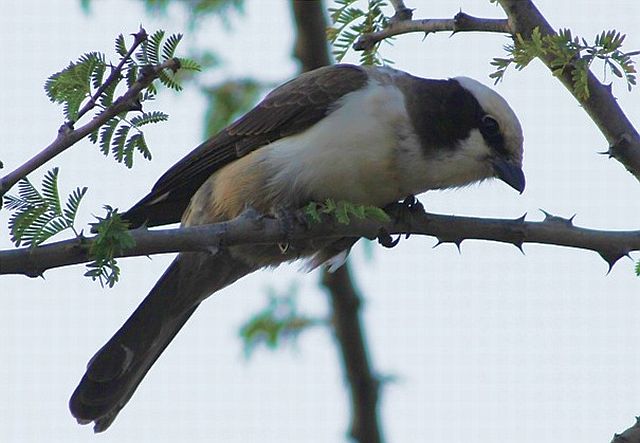 © Amoli
© Amoli
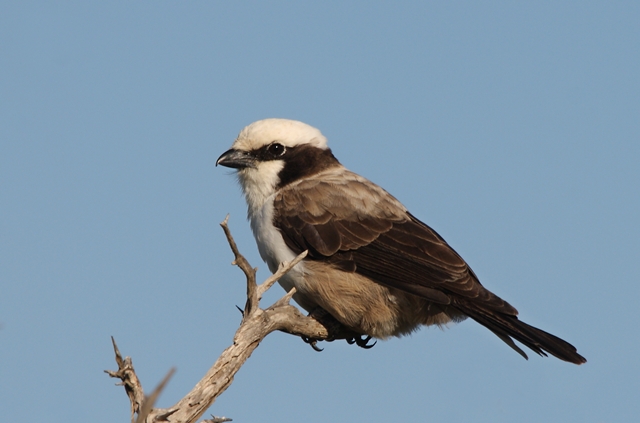 © Flutterby
© Flutterby
Kruger National Park
Links:
Sabap2: http://sabap2.adu.org.za/spp_summary.php?Spp=730
Species text in The Atlas of Southern African Birds: http://sabap2.adu.org.za/docs/sabap1/756.pdf
NEWMAN'S VOELS VAN SA (8ste UIT)
Ian Sinclair. SASOL VOELS VAN SUIDER AFRICA (3de UIT)
Tony Harris. Shrikes and Bush-shrikes
 © BluTuna
© BluTuna © Amoli
© Amoli © Flutterby
© FlutterbyKruger National Park
Links:
Sabap2: http://sabap2.adu.org.za/spp_summary.php?Spp=730
Species text in The Atlas of Southern African Birds: http://sabap2.adu.org.za/docs/sabap1/756.pdf
NEWMAN'S VOELS VAN SA (8ste UIT)
Ian Sinclair. SASOL VOELS VAN SUIDER AFRICA (3de UIT)
Tony Harris. Shrikes and Bush-shrikes
Red-backed Shrike
733. Red-backed Shrike Lanius collurio (Rooiruglaksman)
Order: Passeriformes. Family: Laniidae
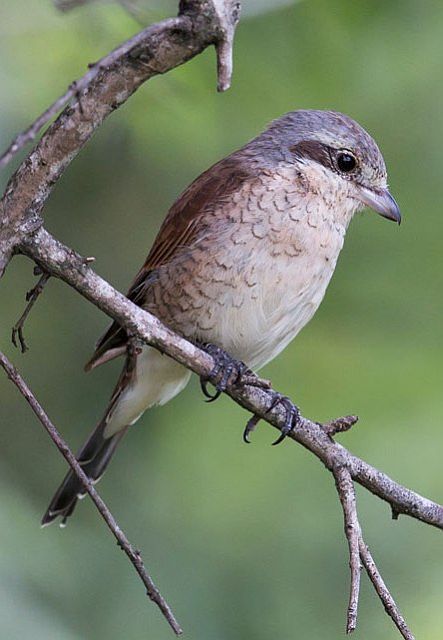 © Pumbaa
© Pumbaa
Female
Description
18 cm. In the region, the only shrike with a chestnut-coloured back and a grey crown.
Males have a bluish-grey head, with a bold black eye-stripe, reddish chestnut coloured back and wings, black tail framed with white, cremy pink underparts and a hooked black bill. Lacks white wingbar of Souza's Shrike.
Females lack the black eye mask of the male and are dull brown; lightly scalloped underparts and fine vermiculations on crown separate it from Marico Flycatcher and Chat Flycatcher.
Juveniles resemble females, but are more heavily vermiculated above with dark bars on their back and crescent-shaped bands covering the body.
Distribution
Its breeding territory is massive - including most of Europe and western Asia. In the non-breeding season it moves south, with most wintering in southern and east-central Africa but some staying further north in Sudan, Egypt and Ethiopia. In southern Africa it is common in most areas, excluding the west coast of Namibia and South Africa and large areas of the Kalahari.
Habitat
Primarily semi-arid open woodland, especially Acacia. It also occurs in grassland with scattered bushes and trees, mopane and broad-leaved woodland. It has gradually been moving into Kalahari scrub, the likely cause being that overgrazing has increased the abundance of thorny bushes.
Habitat preferences differ between the sexes: males favour open habitats with fewer and smaller trees while females prefer denser, especially Acacia woodland.
Movements and migrations
It departs from its breeding grounds mainly during August-September, with the males leaving first, later followed by the females and sub-adults. Most of them arrive synchronously in southern Africa in and around November, later departing during the first half of April.
Diet
It mainly eats arthropods during the non-breeding season, supplemented occasionally with small birds. It often hunts from a perch, catching prey on the ground or on the wing.
Breeding
The cup-like nest is built from plant stems, roots and grass, is lined with moss and hair and is located low down in dense thorny bushes. Eggs are laid between the end of May and late July; only one clutch consisting of three to six eggs is produced each year.
Call
A harsh chack chack alarm call, and males produce a sustained warble in which the songs of other bird species are copied.
http://www.xeno-canto.org/species/Lanius-collurio
Status
Common summer visitor. Non-breading Palearctic migrant; majority arrive mid- to late November, most departing by Apr. The Red-backed Shrike is classified as Least Concern (LC) on the IUCN Red List.
Order: Passeriformes. Family: Laniidae
 © Pumbaa
© Pumbaa Female
Description
18 cm. In the region, the only shrike with a chestnut-coloured back and a grey crown.
Males have a bluish-grey head, with a bold black eye-stripe, reddish chestnut coloured back and wings, black tail framed with white, cremy pink underparts and a hooked black bill. Lacks white wingbar of Souza's Shrike.
Females lack the black eye mask of the male and are dull brown; lightly scalloped underparts and fine vermiculations on crown separate it from Marico Flycatcher and Chat Flycatcher.
Juveniles resemble females, but are more heavily vermiculated above with dark bars on their back and crescent-shaped bands covering the body.
Distribution
Its breeding territory is massive - including most of Europe and western Asia. In the non-breeding season it moves south, with most wintering in southern and east-central Africa but some staying further north in Sudan, Egypt and Ethiopia. In southern Africa it is common in most areas, excluding the west coast of Namibia and South Africa and large areas of the Kalahari.
Habitat
Primarily semi-arid open woodland, especially Acacia. It also occurs in grassland with scattered bushes and trees, mopane and broad-leaved woodland. It has gradually been moving into Kalahari scrub, the likely cause being that overgrazing has increased the abundance of thorny bushes.
Habitat preferences differ between the sexes: males favour open habitats with fewer and smaller trees while females prefer denser, especially Acacia woodland.
Movements and migrations
It departs from its breeding grounds mainly during August-September, with the males leaving first, later followed by the females and sub-adults. Most of them arrive synchronously in southern Africa in and around November, later departing during the first half of April.
Diet
It mainly eats arthropods during the non-breeding season, supplemented occasionally with small birds. It often hunts from a perch, catching prey on the ground or on the wing.
Breeding
The cup-like nest is built from plant stems, roots and grass, is lined with moss and hair and is located low down in dense thorny bushes. Eggs are laid between the end of May and late July; only one clutch consisting of three to six eggs is produced each year.
Call
A harsh chack chack alarm call, and males produce a sustained warble in which the songs of other bird species are copied.
http://www.xeno-canto.org/species/Lanius-collurio
Status
Common summer visitor. Non-breading Palearctic migrant; majority arrive mid- to late November, most departing by Apr. The Red-backed Shrike is classified as Least Concern (LC) on the IUCN Red List.
Red-backed Shrike Photos
733. Red-backed Shrike Lanius collurio (Rooiruglaksman)
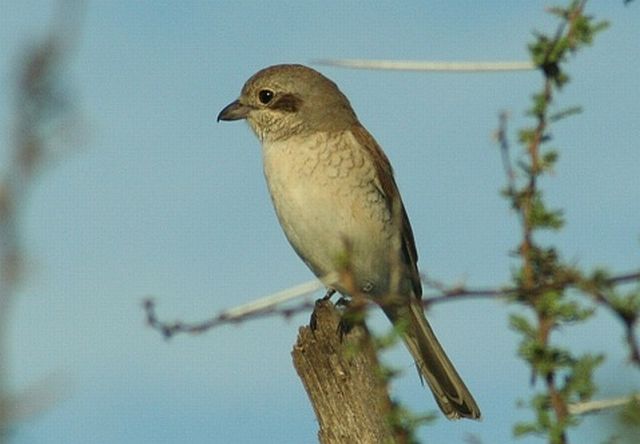 © pooky
© pooky
Female
 © pooky
© pooky
Male
 © Moggiedog
© Moggiedog
Male
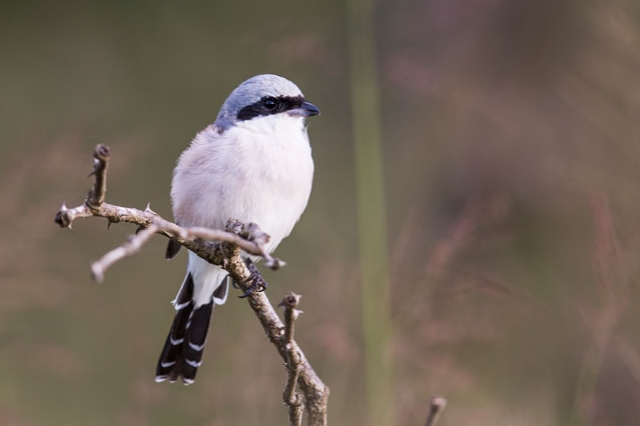 © Pumbaa
© Pumbaa
Male
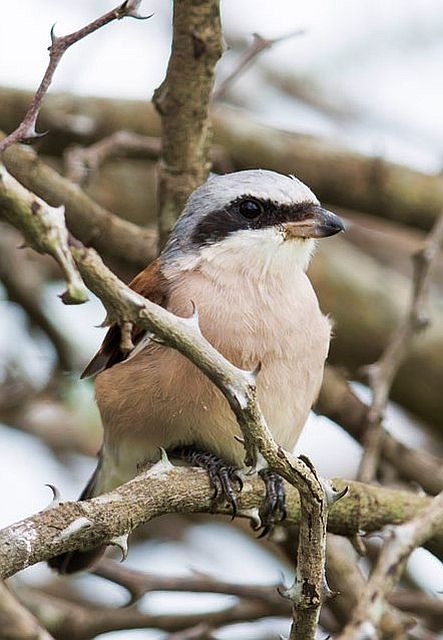 © Pumbaa
© Pumbaa
Male
 © Amoli
© Amoli
Rietvlei Nature Reserve
Links:
http://sabap2.adu.org.za/docs/sabap1/733.pdf
http://sabap2.adu.org.za/spp_summary.ph ... §ion=3
Tony Harris. Shrikes and Bush-shrikes
http://books.google.de/books?id=dOTi7T8 ... an&f=false
http://www.arkive.org/red-backed-shrike ... -collurio/
 © pooky
© pookyFemale
 © pooky
© pookyMale
 © Moggiedog
© MoggiedogMale
 © Pumbaa
© Pumbaa Male
 © Pumbaa
© Pumbaa Male
 © Amoli
© AmoliRietvlei Nature Reserve
Links:
http://sabap2.adu.org.za/docs/sabap1/733.pdf
http://sabap2.adu.org.za/spp_summary.ph ... §ion=3
Tony Harris. Shrikes and Bush-shrikes
http://books.google.de/books?id=dOTi7T8 ... an&f=false
http://www.arkive.org/red-backed-shrike ... -collurio/
- Flutterby
- Posts: 44029
- Joined: Sat May 19, 2012 12:28 pm
- Country: South Africa
- Location: Gauteng, South Africa
- Contact:
Lesser Grey Shrike
731. Lesser Grey Shrike Lanius minor (Grsylaksman)
Order: Passeriformes. Family: Laniidae
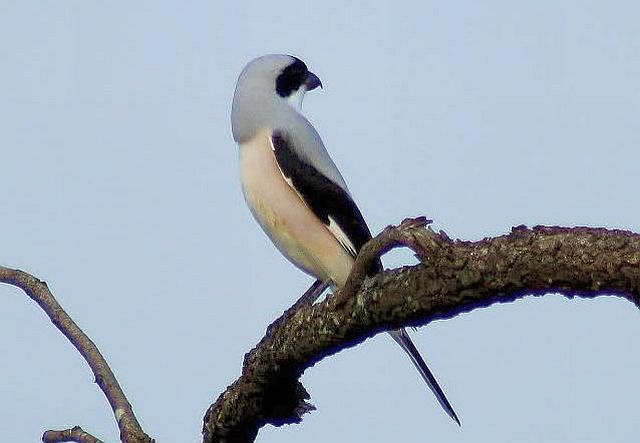
Description
20-22 cm. Medium-sized to large but not strikingly long shrike, with rather stubby bill, apparently black face-mask, which encompasses the forehead, wide white bar across primaries, and wide white edges to tail. Upperparts ashy-blue-grey, a little paler on rump and faintly trimmed whitish along outside of scapulars. Wings black, with wide white patch on base of primaries and whitish tips to tertials, inner secondaries, and primaries. Tail-feathers black on 3 central pairs, black ended on 4th pair, white on others. Salmon pink underparts conspicuous in fresh plumage; not always visible on non-breading grounds.
Sexes similar. The female is duller, often with less black on the forehead and with scattered pale feathers.
Juvenile is paler than adult, more buff above and yellowish below.
Similar species: Grey crown, nape and back easily distinguish it from Northern Fiscal and Southern Fiscal, which have prominent white scapular bar.
Distribution
Its breeding grounds stretch across Eurasia, from Spain to Siberia and north-west China. The bulk of the population stay in southern Africa for the non-breeding season, when it is fairly common in Botswana, Namibia, Limpopo Province, Gauteng, North-West Province and the Northern Cape, with scattered populations in Zimbabwe.
Habitat
Mixed, dry thornveld and semi-desert scrub.
Movements and migrations
It departs from its breeding grounds mainly during the second half of August, passing over the eastern Mediterranean around September and reaching the equator by early November. It eventually arrives in southern Africa around late November-December, staying until March-April the following year.
Diet
It almost exclusively eats arthropods, especially beetles but also termites and butterflies. It usually hunts from perch, pouncing on its prey before flying back to feed. It strangely never hover-hawks in its non-breeding grounds, possibly because of its moulting flight feathers.
Breeding
Breeding starts May-June in Hungary, end of May in Turkey, early May to early July in Russia. Nest site is on a lateral branch up to 4 m from trunk of tree, in fork or in crown, generally at good height above ground. Nest is well-made structure with loose foundation of twigs, grass, rootlets, string, etc., often with high proportion of green plant stems, especially of aromatic species, with leaves and flowers attached. Lined with rootlets, hair, feathers, etc., though often completely without lining. Clutch size 5-6 eggs, incubation for 15-16 days, by female only.
Call
Harsh, grating geer-geer shrek-shrek-shrek notes. Listen to Bird Call.
Status
A common summer visitor. Non-breeding Palearctic migrant; most arrive second half November, and depart March/April.
Order: Passeriformes. Family: Laniidae

Description
20-22 cm. Medium-sized to large but not strikingly long shrike, with rather stubby bill, apparently black face-mask, which encompasses the forehead, wide white bar across primaries, and wide white edges to tail. Upperparts ashy-blue-grey, a little paler on rump and faintly trimmed whitish along outside of scapulars. Wings black, with wide white patch on base of primaries and whitish tips to tertials, inner secondaries, and primaries. Tail-feathers black on 3 central pairs, black ended on 4th pair, white on others. Salmon pink underparts conspicuous in fresh plumage; not always visible on non-breading grounds.
Sexes similar. The female is duller, often with less black on the forehead and with scattered pale feathers.
Juvenile is paler than adult, more buff above and yellowish below.
Similar species: Grey crown, nape and back easily distinguish it from Northern Fiscal and Southern Fiscal, which have prominent white scapular bar.
Distribution
Its breeding grounds stretch across Eurasia, from Spain to Siberia and north-west China. The bulk of the population stay in southern Africa for the non-breeding season, when it is fairly common in Botswana, Namibia, Limpopo Province, Gauteng, North-West Province and the Northern Cape, with scattered populations in Zimbabwe.
Habitat
Mixed, dry thornveld and semi-desert scrub.
Movements and migrations
It departs from its breeding grounds mainly during the second half of August, passing over the eastern Mediterranean around September and reaching the equator by early November. It eventually arrives in southern Africa around late November-December, staying until March-April the following year.
Diet
It almost exclusively eats arthropods, especially beetles but also termites and butterflies. It usually hunts from perch, pouncing on its prey before flying back to feed. It strangely never hover-hawks in its non-breeding grounds, possibly because of its moulting flight feathers.
Breeding
Breeding starts May-June in Hungary, end of May in Turkey, early May to early July in Russia. Nest site is on a lateral branch up to 4 m from trunk of tree, in fork or in crown, generally at good height above ground. Nest is well-made structure with loose foundation of twigs, grass, rootlets, string, etc., often with high proportion of green plant stems, especially of aromatic species, with leaves and flowers attached. Lined with rootlets, hair, feathers, etc., though often completely without lining. Clutch size 5-6 eggs, incubation for 15-16 days, by female only.
Call
Harsh, grating geer-geer shrek-shrek-shrek notes. Listen to Bird Call.
Status
A common summer visitor. Non-breeding Palearctic migrant; most arrive second half November, and depart March/April.
- Flutterby
- Posts: 44029
- Joined: Sat May 19, 2012 12:28 pm
- Country: South Africa
- Location: Gauteng, South Africa
- Contact:
Lesser Grey Shrike Photos
731. Lesser Grey Shrike Lanius minor (Grsylaksman)
 © Dewi
© Dewi
 © Borderline
© Borderline
 © Amoli
© Amoli
 © Mel
© Mel
Links:
Species text Sabap1
Sabap2
NEWMAN'S VOELS VAN SA (8ste UIT)
 © Dewi
© Dewi © Borderline
© Borderline © Amoli
© Amoli © Mel
© MelLinks:
Species text Sabap1
Sabap2
NEWMAN'S VOELS VAN SA (8ste UIT)
- Flutterby
- Posts: 44029
- Joined: Sat May 19, 2012 12:28 pm
- Country: South Africa
- Location: Gauteng, South Africa
- Contact:
Southern Fiscal
732. Southern Fiscal (formerly known as Fiscal Shrike and Common Fiscal) Lanius collaris (Fiskaallaksman)
Order: Passeriformes. Family: Laniidae
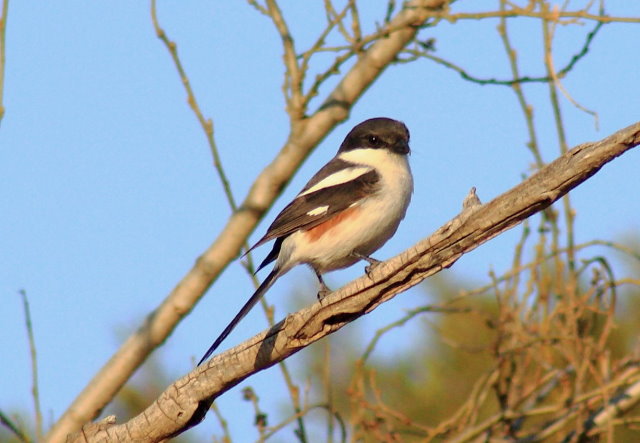 © Flutterby
© Flutterby
Female
Description
A fairly distinctive 21–23 cm long passerine with white underparts and black upperparts extending from the top of the head down to the tail. The bird has a characteristic white 'V' on the back and a relatively long black tail with white outer feathers and white tips on the other feathers. The bill, eyes and legs are black.
Adult male and female Common Fiscals are quite similar except for the rufous lower flank of the female.
A western race L. c. subcoronatus is distinct in showing a clear white eyebrow.
Juvenile is greyish brown, with grey cresent barrings below.
Similar species: The adult Southern Fiscal is distinguished from other black-headed fiscals by the back and tail pattern. Can be confused with the Fiscal Flycatcher, although the white wing bar is restricted to the lower wing of the latter, which also lacks the heavy hooked shrike bill of the Southern Fiscal.
For juveniles a likely source of confusion is with the juvenile Red-backed Shrike, the main differences being:
-the lack of a white eyebrow, which is present in the juvenile Red-backed Shrikes,
-barring on the belly instead of the crescent marks present in the juvenile Red-backed Shrike,
-a browner back than the rufous back of the Red-backed Shrike.
Taxonomy: There are 4 subspecies:
L. c. collaris: Southern Namibia, South Africa to southern Transvaal, Natal and western Swaziland.
L. c. pyrrhostictus: Zimbabwe to northern Transvaal, Natal and eastern Botswana.
L. c. subcoronatus: Namibia to northern Cape Province, Botswana and western Zimbabwe. (Prominent white eyestripe)
L. c. aridicolus: Arid coastal north-western Namibia and south-western Angola.
Distribution
Widespread across sub-Saharan Africa, absent from much of the DRC, Somalia and Ethiopia. In southern Africa it occurs almost everywhere in South Africa, extending into much of Namibia, Zimbabwe and southern Botswana.
Habitat
It occupies a wide variety of habitats but generally prefers open habitats with scattered trees, such as savanna, open woodland, shrubland and grassland. It is also extremely common in man-made habitats such as gardens, parks, farmland and roadsides.
Diet
One of the reasons of this species success lies in its varied diet and clever hunting techniques. It often uses a sit and wait technique in which it hunts from a prominent perch, remaining almost motionless, scanning the area with its sharp eyes. When it spots something it glides to the ground and attempts to catch its prey. If the food item is small it usually eats it on the spot, but if it is larger it either eats it on its perch or impales the animal. Southern fiscals have a catholic diet and are known predators of vertebrates - e.g. blindworms, lizards, chameleons, snakes, frogs, birds, rodents, bats. Prey items are often impaled or wedged on thorns, wood splinters, and barbs of wire fence which serves as a ‘storage’ function or as a display for territorial advertisement and to attract females. However, common fiscal do not cache as much as their northern hemisphere counterparts.
Breeding
It is a monogamous, highly territorial solitary nester. Males defend their territory ferociously against other males, often grabbing their opponent with their claws and then pecking them repeatedly. The female handles most of the nest construction, a process which lasts 2-5 days. It is a thickly walled cup made of twigs, flower heads, bark, grass, leafy herbs and moss, sometimes also including paper, rags, spider web, feathers and cocoons. It is usually placed in the fork of a thorny bush or small tree, building a new nest each breeding season. Typically 2-3 broods are produced within the breeding season each consisting of a 1-5 pale, speckled eggs, usually 3-4 egg clutch. These are incubated mainly by the female for 12-16 days. The chicks are fed mainly by the mostly the female in the first week, after which the male gradually takes more responsibility. They stay in the nest for about 14-21 days and can feed for themselves about 3 weeks later. However, they only become independent after a few more weeks, leaving their parents territory at about 4 months old.
Call
Sustained series of piping and grating notes, including mimicry.
http://www.xeno-canto.org/species/Lanius-collaris
Status
Common resident.
Order: Passeriformes. Family: Laniidae
 © Flutterby
© FlutterbyFemale
Description
A fairly distinctive 21–23 cm long passerine with white underparts and black upperparts extending from the top of the head down to the tail. The bird has a characteristic white 'V' on the back and a relatively long black tail with white outer feathers and white tips on the other feathers. The bill, eyes and legs are black.
Adult male and female Common Fiscals are quite similar except for the rufous lower flank of the female.
A western race L. c. subcoronatus is distinct in showing a clear white eyebrow.
Juvenile is greyish brown, with grey cresent barrings below.
Similar species: The adult Southern Fiscal is distinguished from other black-headed fiscals by the back and tail pattern. Can be confused with the Fiscal Flycatcher, although the white wing bar is restricted to the lower wing of the latter, which also lacks the heavy hooked shrike bill of the Southern Fiscal.
For juveniles a likely source of confusion is with the juvenile Red-backed Shrike, the main differences being:
-the lack of a white eyebrow, which is present in the juvenile Red-backed Shrikes,
-barring on the belly instead of the crescent marks present in the juvenile Red-backed Shrike,
-a browner back than the rufous back of the Red-backed Shrike.
Taxonomy: There are 4 subspecies:
L. c. collaris: Southern Namibia, South Africa to southern Transvaal, Natal and western Swaziland.
L. c. pyrrhostictus: Zimbabwe to northern Transvaal, Natal and eastern Botswana.
L. c. subcoronatus: Namibia to northern Cape Province, Botswana and western Zimbabwe. (Prominent white eyestripe)
L. c. aridicolus: Arid coastal north-western Namibia and south-western Angola.
Distribution
Widespread across sub-Saharan Africa, absent from much of the DRC, Somalia and Ethiopia. In southern Africa it occurs almost everywhere in South Africa, extending into much of Namibia, Zimbabwe and southern Botswana.
Habitat
It occupies a wide variety of habitats but generally prefers open habitats with scattered trees, such as savanna, open woodland, shrubland and grassland. It is also extremely common in man-made habitats such as gardens, parks, farmland and roadsides.
Diet
One of the reasons of this species success lies in its varied diet and clever hunting techniques. It often uses a sit and wait technique in which it hunts from a prominent perch, remaining almost motionless, scanning the area with its sharp eyes. When it spots something it glides to the ground and attempts to catch its prey. If the food item is small it usually eats it on the spot, but if it is larger it either eats it on its perch or impales the animal. Southern fiscals have a catholic diet and are known predators of vertebrates - e.g. blindworms, lizards, chameleons, snakes, frogs, birds, rodents, bats. Prey items are often impaled or wedged on thorns, wood splinters, and barbs of wire fence which serves as a ‘storage’ function or as a display for territorial advertisement and to attract females. However, common fiscal do not cache as much as their northern hemisphere counterparts.
Breeding
It is a monogamous, highly territorial solitary nester. Males defend their territory ferociously against other males, often grabbing their opponent with their claws and then pecking them repeatedly. The female handles most of the nest construction, a process which lasts 2-5 days. It is a thickly walled cup made of twigs, flower heads, bark, grass, leafy herbs and moss, sometimes also including paper, rags, spider web, feathers and cocoons. It is usually placed in the fork of a thorny bush or small tree, building a new nest each breeding season. Typically 2-3 broods are produced within the breeding season each consisting of a 1-5 pale, speckled eggs, usually 3-4 egg clutch. These are incubated mainly by the female for 12-16 days. The chicks are fed mainly by the mostly the female in the first week, after which the male gradually takes more responsibility. They stay in the nest for about 14-21 days and can feed for themselves about 3 weeks later. However, they only become independent after a few more weeks, leaving their parents territory at about 4 months old.
Call
Sustained series of piping and grating notes, including mimicry.
http://www.xeno-canto.org/species/Lanius-collaris
Status
Common resident.
- Flutterby
- Posts: 44029
- Joined: Sat May 19, 2012 12:28 pm
- Country: South Africa
- Location: Gauteng, South Africa
- Contact:
Southern Fiscal Photos
732. Southern Fiscal Lanius collaris (Fiskaallaksman)
 © nan
© nan
Addo Elephant National Park
 Male © Dewi
Male © Dewi

Birds of the arid west have a conspicuous white eyebrow stripe.
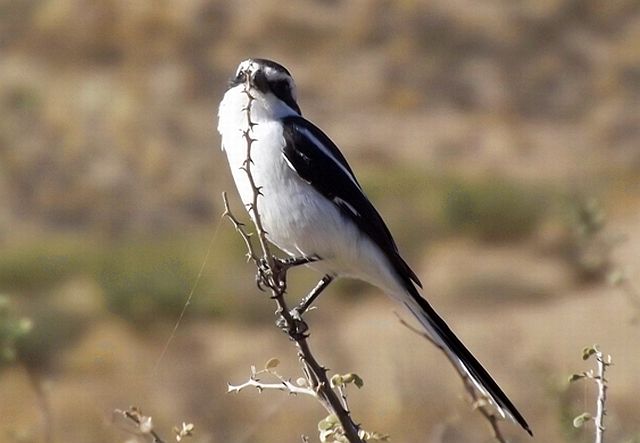 © pooky
© pooky
Western form with the white stripe on the front of the head.
Links:
http://sabap2.adu.org.za/docs/sabap1/732.pdf
http://sabap2.adu.org.za/spp_summary.ph ... §ion=3
NEWMAN'S VOELS VAN SA (8ste UIT)
Harebottle DM 2016. Notes on the vocalisation and additional mimicry in the Common Fiscal Lanius collaris. Biodiversity Observations, Vol 7.5: 1-5
 © nan
© nanAddo Elephant National Park
 Male © Dewi
Male © Dewi
Birds of the arid west have a conspicuous white eyebrow stripe.
 © pooky
© pookyWestern form with the white stripe on the front of the head.
Links:
http://sabap2.adu.org.za/docs/sabap1/732.pdf
http://sabap2.adu.org.za/spp_summary.ph ... §ion=3
NEWMAN'S VOELS VAN SA (8ste UIT)
Harebottle DM 2016. Notes on the vocalisation and additional mimicry in the Common Fiscal Lanius collaris. Biodiversity Observations, Vol 7.5: 1-5


